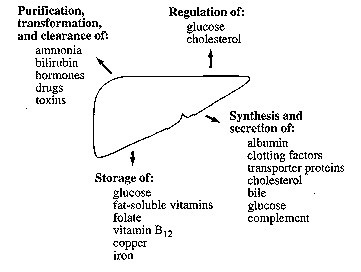 Hepatic Circulation
Hepatic Circulation
![]()
![]() The figure below summarizes the blood flow to and from the liver. As mentioned
above, the liver receives a dual blood supply. The portal vein supplies
blood (from the portal system, the network of veins and capillary beds
draining the intestines and spleen) that is rich in nutrients and absorbed
dietary substances but poor in oxygen. This provides 75% of the liver's
blood supply. The hepatic artery supplies oxygenated blood from the systemic
circulation (aorta) and provides the remaining 25% of the liver's blood
supply.
The figure below summarizes the blood flow to and from the liver. As mentioned
above, the liver receives a dual blood supply. The portal vein supplies
blood (from the portal system, the network of veins and capillary beds
draining the intestines and spleen) that is rich in nutrients and absorbed
dietary substances but poor in oxygen. This provides 75% of the liver's
blood supply. The hepatic artery supplies oxygenated blood from the systemic
circulation (aorta) and provides the remaining 25% of the liver's blood
supply.



Within
the liver, both the portal vein and the hepatic artery branch within the
lobes and eventually converge together into tunnels, or sinusoids , that
run parallel to rows of hepatocytes (liver cells). Sinusoids allow the
exchange of substances between the blood and hepatocytes and merge to form
central veins, which drain blood from the liver into the hepatic vein and
then back to the right heart and lungs via the inferior vena cava. ![]()
![]()